, a wealthy, Jewish merchant from Morocco who had relocated to the commercial center on the Island of St. Thomas in the Caribbean. He dreamed a dream of a safe secure home for the oppressed Jews of Europe suffering under the increasing torments of anti-Semitic European life. He dreamed of a Utopian agrarian community in North Central Florida, on land that he owned were Jews could return to the soil and be free until such time as the Messiah came and they could go home to Israel.
He used his own money to develop Pilgrimage Plantation being cut out of the raw frontier environment of a very difficult and uninviting land filled with challenges few could imagine, ungodly heat and humidity, swamps, isolation, mosquitoes the size of houses, backbreaking labor and Indians.
Pilgrimage Plantation was a sieve for money. Try as Levy had, few Jews wanted to relocate from the cities of Europe to the frontier of Florida. Try as he did, only a few dozen Jews with their families came to Pilgrimage. Pilgrimage Plantation lasted from 1822 1835 until the Seminole Indians permanently ended Levys Jewish dream.
The Seminoles attacked Pilgrimage plantation burning it to the ground. The Seminole War nearly wiped out all settlement in middle Florida. Pilgrimage Plantation was not rebuilt. In time the Florida environment reclaimed the Jewish dream. Levy sank into near poverty for many years. The reality of Pilgrimage disappeared into memory and then into plain forgetfulness.
Early 2016, the State of Florida, the Town of Micanopy and Alachua County have been brought together by the Jewish American Society for Historic Preservation. Together two markers funded by JASHP, one for Moses Elias Levy and one for Pilgrimage Plantation will be dedicated. The forgotten dream of the first Jewish agrarian home in America will be forgotten no longer.
Nearly fifty years after Pilgrimage Plantation was swallowed by the wilds of the Florida frontier, Jews dreamed again of returning to the soil. They dreamed of returning to the soil in a different context than what Levy dreamed for Pilgrimage yet is was the same.
European anti-Semitism had not improved by the latter half of the 19th century. If anything it became more vicious. What to do with the Jews was the standard question among Europes finer circles. The Jewish question was the worst in Russia and its vassal areas of Eastern Europe. Jews had been squeezed into an unlivable, small restricted area called the Pale of Settlement.
The Russian solution to the Jewish question was simple, make their lives so miserable, they convert to Christianity, they will voluntarily leave Russia or even more simple, they will die.
Millions of Jews, between 1880-1920, voted for life with their feet. They left Russia with nostalgia for their Yiddish culture, a burning hatred for the Czar and the dream of reaching America. For those who made it to America, most settled in the urban areas of the Eastern seaboard, Boston, Philadelphia, and New York in particular. They had removed themselves from the hated Russian lands only to descend into the urban Hell of monstrous, tenement congestion and near slave wage labor servitude. They were free but their bodies, their families and their children were oppressed almost without hope of liberation.
A liberation movement did begin. America was huge and desperate for settlers to come in and move to the frontier of the American West. America wanted immigrants to turn the virgin sod and plant the soil with fertile farms and democracy. The various Homestead Acts offered land, 160 acres nearly free to anyone who would settle on the land and develop it for five years. For Jews, living within a culture that was inwardly restrictive, not freely lending itself to individual independence beyond walking distance to the synagogue and the physical limits of kosher life, hated by non-Jews outside their self-imposed or imposed ghetto walls, the freedom of the American frontier was an enigma. They knew they could escape the tenements but could they escape being Jewish. If they left the confines of the minyan and went out on their own they became alone. They faced the death of who they were as Jews.
The American frontier emerged as a new opportunity for Jews as it has for Christians. For Jews it was different. Jews generally did not go to the frontier alone. They could and did return to the land, frequently in Yiddish speaking communities. They could organize themselves into idealistic farming settlements of mutual support and maintain their identity as Jews. They could create Jewish solutions to the Jewish urban hell of the Eastern cities.
Jews could show to the outside world that Jews were not economic parasites. They could successfully make their living from the land as free and equal people with their neighbors. Jews did not have to live and die as economic slaves to the power of capital but could take their children, their families along with their friends and start Jewish communities on the frontiers of America. They could return to the soil, even if it was not the soil of the true Zion. It was the soil of the New Zion, America.
Between 1880 and 1911 over twenty five Jewish return to the soil agrarian efforts were attempted. Most were utopian and communal in character. Most began as quasi socialist communal endeavors clearing and settling the land. All eventually failed for a variety of reasons, lack of capital, lack of agricultural experience, natural calamity, disease, internal dissensions, etc. The very nature of communal ownership failed when faced with the challenge of the frontier. The evident benefits of private ownership of land and labor gave the fruits to those who were the best not just because they were members of the group. Individual initiative proved more enduring than the initial communal need. With their eventual dissolutions, a few private Jewish farms did survive into the 20th century, but only a few.
One Jewish agricultural community did do well into today, the Jewish agricultural efforts in the Vineland/Woodbine, N.J. area. Many Eastern Jewish homes have stories about great Uncle Morty and his Chicken farm in N.J. The settlements eventually succeeded because they were heavily subsidized by Jewish philanthropists and the pragmatic beneficial proximity to large Jewish urban areas. Manufacturing was brought in when agriculture proved woefully insufficient to support the purist dreams of returning to the land.
Yet it was in the West, far from the large centers of concentrated Jewish life in the East that Jews were forced to face the hash necessity to adapt. The frontier was liberating and the frontier was also threatening. Most Jews chose to remain in their constricting urban cocoons but some did hear the Clarion call of the West.
After getting the Moses Elias Levy and Pilgrimage Plantation markers underway, I wondered again about the Jewish agricultural settlements of the West. JASHP had already done a historic interpretive marker at the site of the failed Jewish settlement of Cotopaxi, high in the Rocky Mountains along the Arkansas River.
Cotopaxi failed because the Jewish settlers had been sold a bill of goods by other Jews who wished them to relocate to their lands. Woefully inadequate financial support, promised, never delivered infrastructure, extreme environmental challenges, isolation, lack of agricultural skills, crop failures, for that location guaranteed failure.
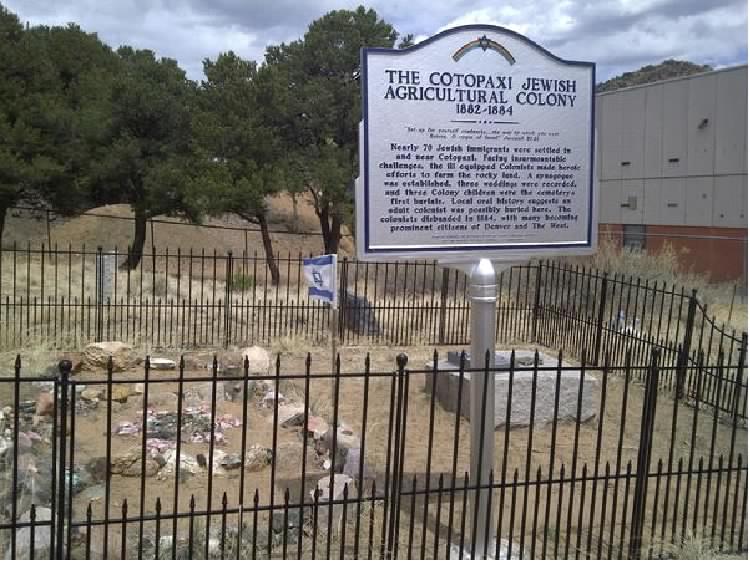
http://www.jewish-american-society-for-historic-preservation.org/programsalabamakansas/cotopaxicolorado.html
Nothing is left of the Jewish settlement in Cotopaxi except for some foundational ruins and a small cemetery respectfully cared for by a local Christian family.
Searching the web and roaming over Jewish agricultural histories, I read about the last major Jewish agricultural effort in the U.S., Clarion, Utah. A footnote referred to a book about Clarion, written by a Jewish history professor at Utah University in Salt Lake, City. The book was titled Back to the Land. It was written by Dr. Robert (Bob) Goldberg.
Chutzpah is a Jewish characteristic. I looked up Professor Goldberg and wrote to him. I asked if there were any Jewish historic marker opportunities in Utah that JASHP could consider being involved in. 2014, David Epstein of the Jewish Museum of the American West had referred Wade Allinson to me. Wade wanted to do a historic interpretive marker for the John C. Fremonts 1853 mission of exploration. Solomon Carvallho, a Jew with specific skills as a cartographer and photographer was a key member of the expedition. A historic interpretive marker recognizing the Fremont expedition and telling the story of Solomon Carvallho was dedicated at Wild Horse Butte next to Goblin State park in Utah.
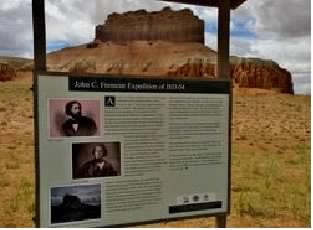
http://www.jewish-american-society-for-historic-preservation.org/programsutahwyoming/wildhorsebutteutah.html
Being a smart Jew from the East, I figured by late April the weather would be good for the dedication. It rained ice and hail, the wind blew bitter cold. It felt like Fremont and Carvallo were laughing at me. The Westerns came out to the dedication. I was the only Jew. Jews on the frontier were never great in number. But, we were fundamental parts of the story of the American West.
Calling Bob Golderg was bashert. He placed me in contact with Monte Bona, the director of the Mormon Pioneer Heritage Area organization. Monte was seeking funds to create an interpretive Kiosk for the Clarion Jewish Agricultural effort of 1911-1915, in Gunnison, Utah.
It was a shiddach that was bashert. It was a marriage that was meant to be.
Monte needed funds to match a potential grant from the U.S. Department of the Interior to create the Gunnison Kiosk that would tell the story of the Jewish Agricultural dream of Clarion in Utah. JASHP provided the matching Grant funding. Together we made it happen.
Four years earlier, on the 100th anniversary of the founding of Clarion, descendants of the colony, along with members of the Utah community and the citizens of Gunnison gathered to commemorate the founding of Clarion. A musical celebration was presented in the historic Star Casino Theater in Gunnison that was being restored. Memories were shared, stories in the papers were written and the next day, Clarion was again forgotten. Two lonely Jewish graves out on the range of a dairy farmer, a few foundations, were all that remained of Clarion.
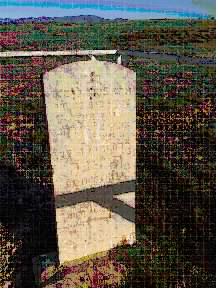
Aaron Binder 1913
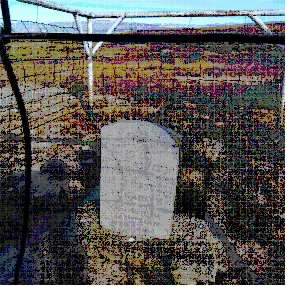
Edward Lieberman - 1914
Monte wanted to create a permanent interpretive memory that told the story of the Jewish move to Zion, the Jewish move to where they were wanted and where they could dream freely on the land.
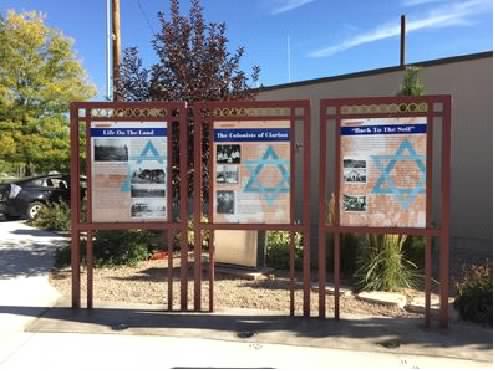
http://www.jewish-american-society-for-historic-preservation.org/programsutahwyoming/clarionutah.html
September 25, at 6:00 pm in the evening, Shabbat, the Clarion Kiosk was dedicated with speeches, music and memories in Gunnison, Utah. The Kiosk, with its three vertical interpretive panels, prominently and proudly told the story of Clarion. The memory of Clarion, the dreams, the hopes, the story and its end, lived and will continue to live.
The Clarion Kiosk text was written by Bob Goldberg. The panel stories were set with pictures and large prominent background Stars of David without fears of political correctness that someone would be offended by the Jewish symbol. The Clarion Kiosk in Gunnison will tell the story of Clarion for many years to come.
Bob Goldberg summed up the meaning of Clarion succinctly and deep understanding insight.
"It (Clarion) isn't just a story about a failed attempt at colonization. It's a story of idealism, vision, purpose and sacrifice, and of people trying to do something good for their people.
"That they failed is their history that they dreamed and struggled and were greater than themselves is their legacy.
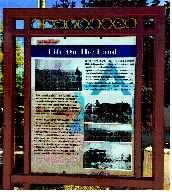
Life on the Land
In 1911, the Jewish Agricultural and Colonial Association of Philadelphia purchased6,085 acres of land and water rights from the Utah State Land board for the agricultural experiment that they would name Clarion. Members of the association tasked with selecting a site for the future colony reported to their friends and neighbors in Philadelphia, Baltimore, and New York city that the soil was fertile, that a new source of irrigation, the state-built Piute Canal, would soon be completed, and that in all respects this site would meet the needs and aspirations of the would-be farmers.
Clarion was to be settled in phases, beginning with the arrival of twelve men who would work collectively to prepare the land for planting and irrigation. Thereafter, the land would be divided into family farmsteads with equipment shared by the settlers. Families would arrive 50 at a time, from year to year, until all of the Association members had been relocated from the East.
Unfortunately, the Clarion settlers found that life in arid Utah was quite different from the promises made by their back to the-soil leaders and Utah state officials. The soil proved to be very poor and only productive with extensive irrigation. While the success of the colony depended on a reliable supply of water for both irrigation and domestic needs, construction of the Piute
Canal, intended to be completed before the arrival of the colonists in 1911, was not even finished until 1918, two years after the demise of Clarion. The limited water that was available was insufficient to meet the needs of the colony and the requirements of the land itself to become fully productive.
Panel 2:
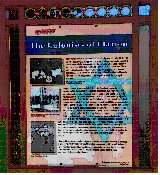
The Colonists of Clarion
For the Jewish settlers who came to Utah, Clarion was not just a theoretical experiment; it was a real opportunity to escape the poverty and stress of life in the ghettos of the eastern cities, for themselves as well as their families. As the colonys name reveals, they also looked beyond themselves. These colonists had sounded a Clarion call to all Jews to return to the land for spiritual and physical revival. In Utah, they believed that they had found a haven from the violence of the European pogroms and the poverty of America.
Benjamin Brown recommended the Utah site for colonization to the other members of the Association and was the leader of the settlers in Clarion. The colonists raised wheat, alfalfa, and oats and kept chickens and cows on their forty-acre farms. The Association subsidized families with a weekly stipend to ease the transition from city to farm. At its high point, more than two hundred men, women and children lived in the colony and over 2,800 acres were under cultivation. Relations with local Mormon farmers were valuable for they helped the Jewish colonists gain experience in working the land and raising animals. But, tragedy marked the life of the Jewish colony. The Piute Canal failed to deliver promised water. Early and late frosts and heavy rainfall that flooded fields brought crop failures. A lack of experience aggravated natural calamities, and dissension rooted in ideology, missed expectations, and personality conflicts weakened morale. The deaths of two farmers and the loss of two babies further weakened the will to stay on the land. In 1915, the colony could not make payment on the land and the State of Utah foreclosed. Most colonists returned to their former homes in the eastern cities. Un willing to give up on their dream, half a dozen Jewish families took up land near the Clarion tract and successfully farmed into the late 1920s.
The hurdles to success on the land proved too high and the Jewish farmers could not sustain their experiment. Nor would they lead a movement of Jews back to the soil. Yet, their story is one of hope and determinations to better themselves and a people. That they failed is their history. That they dreamed and struggled against insurmountable odds is their legacy.
Panel 3:
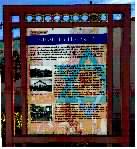
Back to the Soil
From the beginning of the Common Era and into the nineteenth century, European Jews were prohibited from owning land. By necessity, Jews abandoned an agrarian existence and turned to a more urban way of life, becoming instead shopkeepers, peddlers, and artisans. But, by the middle of the 19th Century, Jewish reformers and Zionist nationalists advocated a return to a purer life and occupations based on manual labor. Key to this was agriculture. As early as the 1840s Jewish communal societies were proposed in both Europe and in America where it was hoped Jews could achieve these ideals by returning to the soil.
The pogroms (violent and usually deadly anti-Jewish riots) of the 19th Century saw the emigration of hundreds of thousands of Jews, mostly from Eastern Europe, who came to America with hopes of religious and economic freedom. The great majority of the Jews settled in the eastern cities. Others participated in an international movement that saw farm colonies planted in the United States, Canada, Argentina, Brazil and Israel. Forty agricultural colonies were organized in the United States at places such as Sicily Island, Louisiana, Crimea and Painted Woods in South Dakota; new Odessa, Oregon; and Cotopaxi in Colorado. Clarion, Utah was the largest in population and land areas and was in existence the longest of any settlement west of the Appalachian Mountains. Many communities suffered catastrophic natural disasters, while others succumbed to mismanagement, poor soils, and settlers unfamiliarity with farm practices. All but a couple failed and were abandoned with a few years of their founding. Today, virtually all have disappeared.
In the early 20th Century, renewed pogroms and emigration from Eastern Europe added to the already overcrowded conditions in the cities of the eastern United States. Even president Theodore Roosevelt endorsed for all Americans a Back to the Farm movement and established the country Life Commission in 1908 to seek means to keep farmers on the land and to encourage new agricultural enterprises. These ideas would have been familiar to Jewish immigrants who had head similar schemes in their homelands even before their popularity in America.
~ ~ ~ ~ ~ ~ ~ ~ ~ ~ ~ ~ ~ ~ ~ ~ ~ ~
Honoring the Jewish settlement of Clarion, Utah, a concurrent resolution of the Utah Legislature and Governor was passed. The words, written with sincerity, respect and decorum reflect the support of the people of Utah for the Clarion project then and honors them today.
1 CONCURRENT RESOLUTION RECOGNIZING THE lOOTH
2 ANNIVERSARY OF THE SETTLEMENT OF CLARION,
3 UTAH
4 2015 GENERAL SESSION
5 STATE OF UTAH
6 Chief Sponsor: Jon Cox
7 Senate Sponsor: Jim Dabakis
9 LONG TITLE
10 General Description:
This concurrent resolution of the Legislature and the Governor recognizes the 1OOth
11 anniversary of the settlement of Clarion, Utah.
12 Highlighted Provisions:
13 This resolution:
14 recognizes the 1OOth anniversary of the settlement of Clarion, Utah.
15 Special Clauses:
16 None
19 Be it resolved by the Legislature of the state of Utah, the Governor concurring therein:
20 WHEREAS, for centuries European Jews were prohibited from owning land and were
21 forced to abandon an agrarian existence for a more urban way of life;
22 WHEREAS, by the middle of the 19th Century, Jewish reformers advocated the Jews'
23 return to a "purer life" based on occupations that required manual labor;
24 WHEREAS, in 1911, the Jewish Agricultural and Colonial Association of Philadelphia
25 purchased 6,085 acres of land and water rights in southern Sanpete County from the Utah State
26 Land Board for an agricultural experiment that they named Clarion;
27 WHEREAS, members of the association who traveled to Utah reported to their friends
28 and neighbors back east that the soil was fertile, that they were given official assurance that the
29 Piute Canal would soon be completed as a new source of irrigation water, and that Clarion
30 would meet the needs and aspirations of would-be farmers;
31 WHEREAS, Clarion land was settled in phases, beginning with the arrival of 12 men
32 who worked collectively to prepare the land for planting and irrigation, and was divided into
33 family farmsteads as more settlers arrived;
34 WHEREAS, at its high point, more than 200 men, women, and children lived in the
35 Jewish colony and cultivated over 2,800 acres of land;
36 WHEREAS, Clarion became one of the largest Jewish agrarian colonies west of the
37 Appalachian Mountains;
38 WHEREAS, the Clarion colonists found that life in arid Utah was different from the
39 promises made by their leaders and Utah state officials, as the soil proved to be very poor and
40 only productive with extensive irrigation;
41 WHEREAS, the Piute Canal, a necessary source of water for the farmers, was not
42 finished until 1918, two years after the demise of Clarion;
43 WHEREAS, colonists' morale was weakened by early and late frosts, heavy floods,
44 crop failures, inexperience, and internal dissension;
45 WHEREAS, the deaths of two farmers and the loss of two babies in 1915 further
46 weakened the colonists' will to stay in Clarion, and when the colony could not make payment
47 on the land, the state of Utah foreclosed;
48 WHEREAS, most colonists returned to their former homes in eastern cities while a few
49 Jewish families, unwilling to give up on their dream, settled land near Clarion where they
50 successfully farmed into the late 1920s;
51 WHEREAS, for the Jewish settlers who came to Utah, Clarion was not just a
52 theoretical experiment - it was a real opportunity, for themselves and their families, to escape
53 the pove1iy and stress of life in the ghettos of eastern cities;
54 WHEREAS, these colonists had sounded a clarion call to all Jews to return to the land
55 for spiritual and physical revival;
56 WHEREAS, in Utah, they believed that they had found a haven from the violence of
57 the European pogroms and the poverty of American cities;
58 WHEREAS, the hurdles to success in Utah proved too high and the Jewish farmers
59 could not sustain their experiment nor lead a movement of Jews back to the soil; and
60 WHEREAS, that they failed is their history, that they dreamed and struggled against
61 insurmountable odds is their legacy:
62 NOW, THEREFORE, BE IT RESOLVED that the Legislature of the state of Utah, the
63 Governor concurring therein, recognizes the l00th anniversary of the settlement of Clarion,
64 Utah, and urge the citizens of the state to remember the determination, fortitude, and sacrifice
65 of those who struggled to start a new life there.
66 BE IT FURTHER RESOLVED that the Legislature and the Governor recognize that the
67 story of the settlers of Clarion is one of hope and determination to better themselves and a
68 people.
Jerry Klinger is President of the Jewish American Society for Historic Preservation
www.JASHP.org.